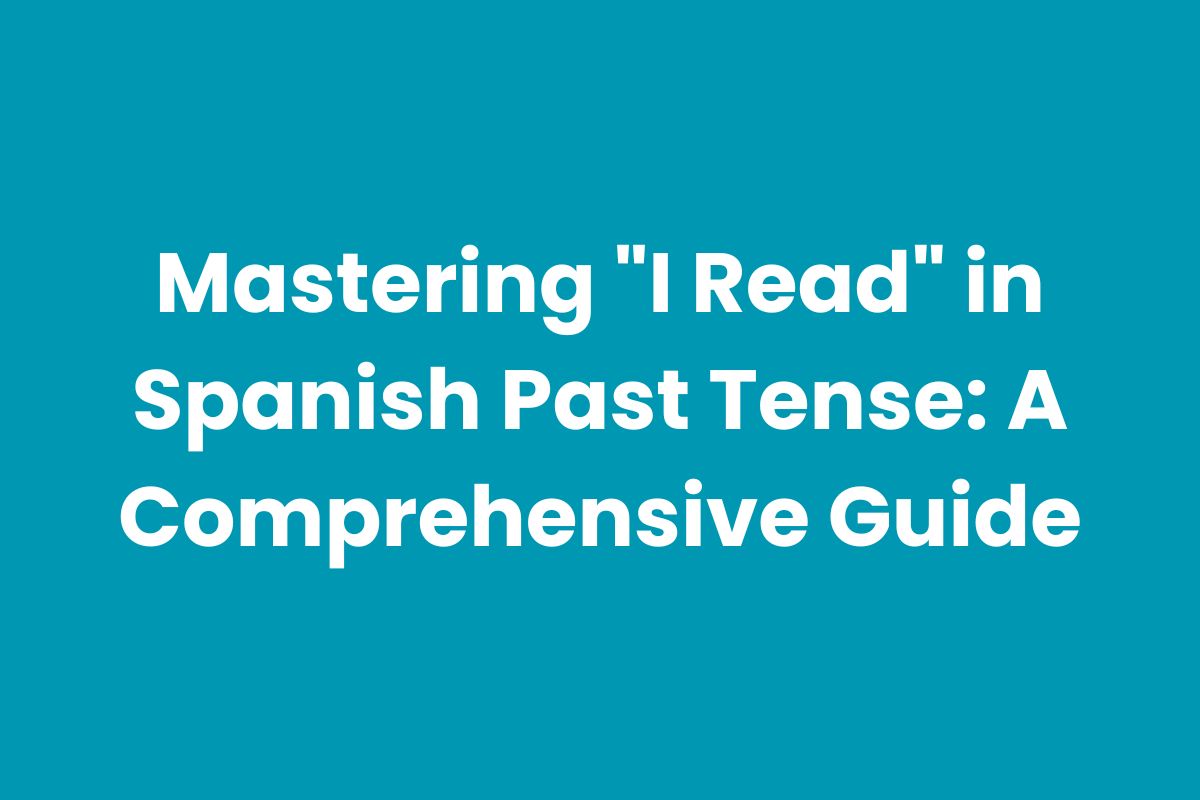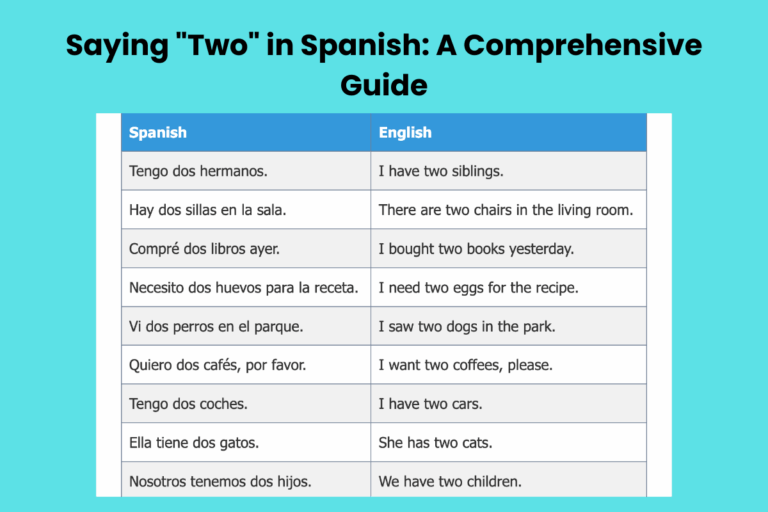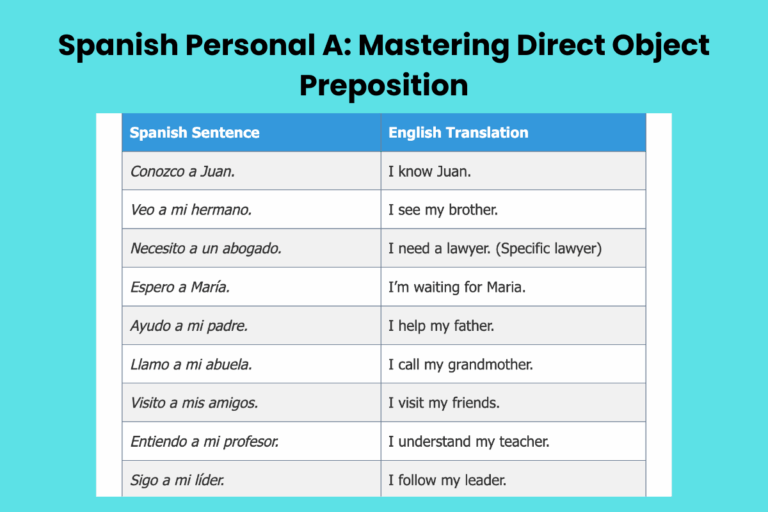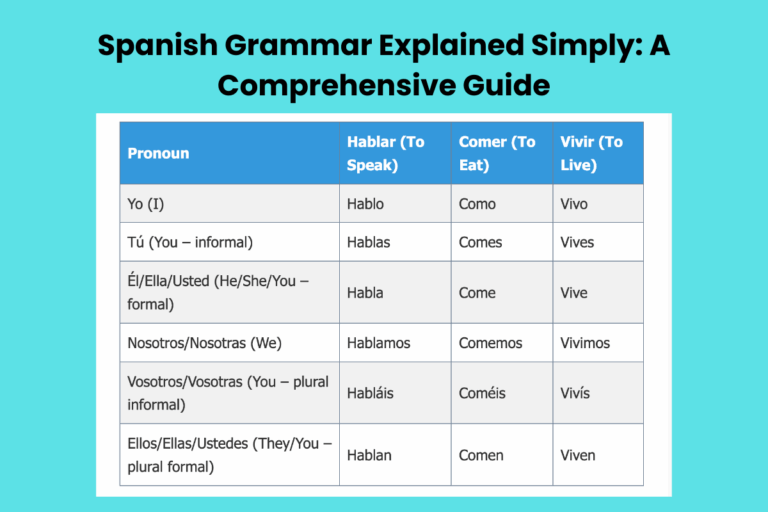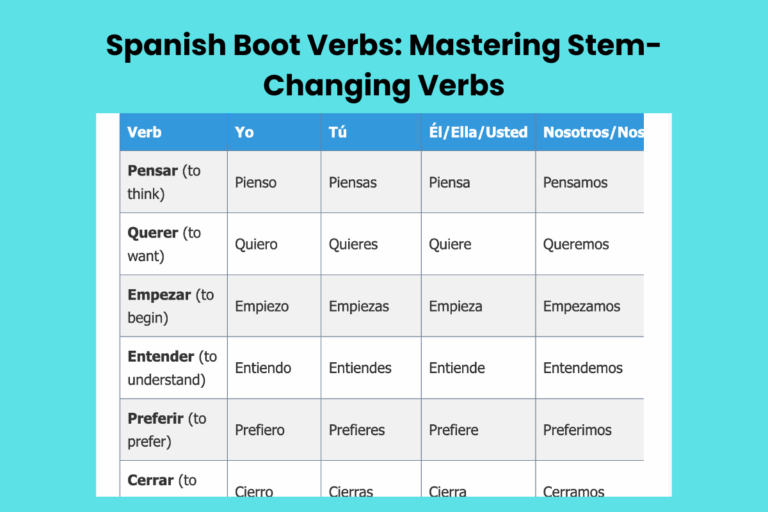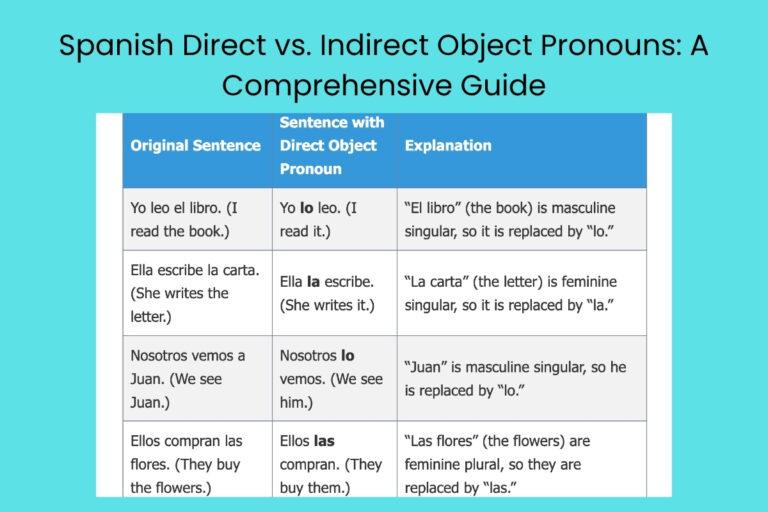Mastering “I Read” in Spanish Past Tense: A Comprehensive Guide
Understanding how to express “I read” in the Spanish past tense is crucial for narrating past events and engaging in meaningful conversations. Spanish, like many languages, has multiple past tenses, each conveying different nuances of time and completion.
This guide will provide a comprehensive overview of the past tenses used to translate “I read,” focusing on the preterite and imperfect tenses. This article is designed for students of all levels, from beginners seeking to grasp the basics to advanced learners aiming to refine their understanding and usage.
Table of Contents
- Introduction
- Definition: Expressing “I Read” in Spanish Past Tense
- Structural Breakdown of Spanish Past Tenses
- Types of Past Tenses for “I Read”
- Examples of “I Read” in Different Past Tenses
- Usage Rules for Preterite and Imperfect
- Common Mistakes When Using Past Tenses
- Practice Exercises
- Advanced Topics: Nuances and Subtleties
- Frequently Asked Questions
- Conclusion
Definition: Expressing “I Read” in Spanish Past Tense
In Spanish, translating “I read” in the past tense isn’t as straightforward as simply finding one equivalent. The most common ways to express this are through the preterite (also known as pretérito indefinido or pretérito perfecto simple) and the imperfect (pretérito imperfecto) tenses. Each tense has distinct uses, conveying different aspects of when and how the reading occurred.
The preterite tense is used to describe actions that were completed at a specific point in the past. It emphasizes the finished nature of the action. The imperfect tense, on the other hand, describes ongoing or habitual actions in the past, or provides background information or descriptions. Choosing the correct tense depends on the context and the intended meaning.
Structural Breakdown of Spanish Past Tenses
Understanding the structure of Spanish past tenses is essential for accurate conjugation and usage. Both the preterite and imperfect tenses have specific endings that are added to the verb stem.
The verb stem is obtained by removing the infinitive ending (-ar, -er, or -ir) from the verb.
For regular verbs, the preterite and imperfect endings are predictable. However, irregular verbs have unique conjugations that must be memorized.
Mastering these conjugations is crucial for fluency in Spanish. Understanding the patterns and exceptions will help you navigate the complexities of Spanish verb tenses.
Types of Past Tenses for “I Read”
Preterite Tense (Pretérito Indefinido)
The preterite tense is used to describe actions that were completed at a specific point in the past. It is often used for single, completed events, or for a series of events that occurred in a defined time frame. For the verb leer (to read), the preterite form for “I read” is leí.
The preterite tense focuses on the beginning and end of an action, emphasizing its completion. It presents the action as a finished event, without implying any duration or repetition.
This tense is commonly used in narratives, historical accounts, and when recounting past experiences.
Imperfect Tense (Pretérito Imperfecto)
The imperfect tense describes ongoing or habitual actions in the past. It is used for actions that were in progress, for descriptions of past states, and for providing background information. For the verb leer, the imperfect form for “I read” is leía.
The imperfect tense emphasizes the duration or repetition of an action, rather than its completion. It is often used to describe what someone used to do or was doing. This tense is useful for setting the scene, describing habits, and expressing continuous actions in the past.
Other Past Tenses (Brief Overview)
While the preterite and imperfect are the most common ways to translate “I read” in the past, other past tenses exist in Spanish. The preterite perfect (pretérito perfecto compuesto) is used for actions completed in the recent past that still have relevance to the present. The pluperfect (pretérito pluscuamperfecto) describes actions completed before another past action. These tenses are less common for directly translating “I read” but are important for a comprehensive understanding of Spanish past tenses.
Examples of “I Read” in Different Past Tenses
Here are examples of how to use “I read” in the preterite and imperfect tenses, illustrating the differences in meaning and context.
| Tense | Spanish | English Translation | Context |
|---|---|---|---|
| Preterite | Leí un libro ayer. | I read a book yesterday. | Completed action in the past. |
| Preterite | Leí el periódico esta mañana. | I read the newspaper this morning. | Completed action within a defined period. |
| Preterite | Leí todos los capítulos del libro. | I read all the chapters of the book. | Completed action with a clear end. |
| Preterite | Leí esa novela en una semana. | I read that novel in a week. | Action completed within a specific timeframe. |
| Preterite | Cuando era niño, leí muchos cuentos. | When I was a child, I read many stories. | Series of completed actions (focus on completion). |
| Preterite | Leí la carta y luego la quemé. | I read the letter and then burned it. | Sequence of completed actions. |
| Preterite | Anoche leí hasta tarde. | Last night I read until late. | Action completed at a specific time. |
| Preterite | Leí un poema hermoso. | I read a beautiful poem. | Completed action of reading a specific poem. |
| Preterite | Leí el mensaje en mi teléfono. | I read the message on my phone. | Completed action of reading a specific message. |
| Preterite | Leí sobre la historia de España. | I read about the history of Spain. | Completed action of reading about a topic. |
| Imperfect | Cuando era niño, leía muchos libros. | When I was a child, I used to read many books. | Habitual action in the past. |
| Imperfect | Mientras esperaba, leía una revista. | While I was waiting, I was reading a magazine. | Action in progress in the past. |
| Imperfect | Leía todas las noches antes de dormir. | I used to read every night before sleeping. | Recurring action in the past. |
| Imperfect | En ese tiempo, leía mucho sobre filosofía. | At that time, I read a lot about philosophy. | Habitual action over a period. |
| Imperfect | Leía el libro mientras viajaba en tren. | I was reading the book while traveling by train. | Ongoing action in the past. |
| Imperfect | Siempre leía antes de ir a la escuela. | I always read before going to school. | Habitual action in the past. |
| Imperfect | Leía para relajarme. | I used to read to relax. | Past habit or purpose. |
| Imperfect | Leía los cuentos a mis hijos. | I used to read stories to my children. | Repeated action in the past. |
| Imperfect | Antes, leía muchos periódicos. | Before, I used to read many newspapers. | Past habit. |
| Imperfect | A menudo leía en la biblioteca. | I often read in the library. | Frequent past action. |
| Preterite | Ayer por la tarde leí un artículo interesante. | Yesterday afternoon I read an interesting article. | Specific completed action. |
| Preterite | El año pasado leí tres novelas de García Márquez. | Last year I read three novels by García Márquez. | Completed actions within a specific period. |
| Imperfect | Antes de tener internet, leía mucho más. | Before having the internet, I used to read much more. | Habitual action contrasted with the present. |
| Imperfect | Mientras cocinaba, leía recetas. | While I was cooking, I was reading recipes. | Action in progress alongside another action. |
| Imperfect | En mi juventud, leía poesía con frecuencia. | In my youth, I used to read poetry frequently. | Recurring action during a period of life. |
This table illustrates how the choice between preterite and imperfect significantly alters the meaning of “I read” in Spanish.
| Tense | Conjugation of Leer (to read) |
|---|---|
| Preterite | Yo leí (I read) |
| Imperfect | Yo leía (I used to read/I was reading) |
The following table provides more examples, focusing on nuances of the preterite and imperfect tenses.
| Tense | Spanish Sentence | English Translation | Explanation |
|---|---|---|---|
| Preterite | Leí el libro completo en dos días. | I read the entire book in two days. | Completed action within a specific timeframe. |
| Preterite | Leí la noticia y me sorprendí. | I read the news and was surprised. | Completed action that led to another event. |
| Preterite | Ayer leí un correo electrónico importante. | Yesterday I read an important email. | Specific completed action. |
| Preterite | En la universidad leí muchas obras clásicas. | At university, I read many classic works. | Completed actions during a specific phase of life. |
| Preterite | Leí el letrero antes de entrar. | I read the sign before entering. | Completed action preceding another action. |
| Preterite | Leí el contrato cuidadosamente. | I read the contract carefully. | Emphasizes the completed action and thoroughness. |
| Preterite | Cuando llegué a casa, leí un rato. | When I got home, I read for a while. | Specific period of reading within a larger event. |
| Preterite | Leí todos los documentos necesarios. | I read all the necessary documents. | Completed action with a specific scope. |
| Preterite | Leí la introducción y decidí comprar el libro. | I read the introduction and decided to buy the book. | Completed action leading to a decision. |
| Preterite | Leí un cuento corto antes de dormir. | I read a short story before sleeping. | Specific completed action at a specific time. |
| Imperfect | Antes leía novelas de ciencia ficción, ahora leo más historia. | Before, I used to read science fiction novels, now I read more history. | Contrasting past and present habits. |
| Imperfect | Cuando vivía en España, leía el periódico todos los días. | When I lived in Spain, I used to read the newspaper every day. | Habitual action during a specific period. |
| Imperfect | Leía en voz alta para practicar mi pronunciación. | I used to read aloud to practice my pronunciation. | Past habit with a specific purpose. |
| Imperfect | Mientras esperaba al autobús, leía un libro. | While I was waiting for the bus, I was reading a book. | Action in progress as background to another action. |
| Imperfect | Leía con dificultad porque no tenía gafas. | I used to read with difficulty because I didn’t have glasses. | Describing a state during a past action. |
| Imperfect | Siempre leía en el mismo sillón junto a la ventana. | I always used to read in the same armchair by the window. | Habitual action in a specific location. |
| Imperfect | Cuando era joven, leía cuentos de hadas. | When I was young, I used to read fairy tales. | Habitual action during a period of life. |
| Imperfect | Leía para olvidarme de mis problemas. | I used to read to forget about my problems. | Past habit with a specific motivation. |
| Imperfect | Leía las cartas que me enviaba mi abuela. | I used to read the letters that my grandmother sent me. | Repeated action in the past. |
| Imperfect | Leía con mucha atención cada palabra. | I used to read each word very carefully. | Describing the manner of reading as a past habit. |
This table contrasts the preterite and imperfect tenses, highlighting their distinct uses and meanings.
Usage Rules for Preterite and Imperfect
Preterite Usage Rules
Use the preterite tense for:
- Completed actions: Actions that have a clear beginning and end.
- Specific events: Actions that happened at a specific point in the past.
- Single actions: Actions that happened only once.
- Actions that interrupt another action: Although the interrupting action will be in the preterite, the interrupted action will be in the imperfect.
- Actions in a sequence: A series of completed actions.
Imperfect Usage Rules
Use the imperfect tense for:
- Ongoing actions: Actions that were in progress in the past.
- Habitual actions: Actions that were repeated regularly in the past.
- Descriptions of past states: Describing how things were in the past.
- Background information: Setting the scene or providing context.
- Actions happening simultaneously: Two or more actions occurring at the same time, often introduced by mientras (while).
Signal Words and Phrases
Certain words and phrases often indicate which tense should be used. These signal words can help you determine whether to use the preterite or the imperfect tense.
Preterite Signal Words:
- Ayer (yesterday)
- Anoche (last night)
- El año pasado (last year)
- La semana pasada (last week)
- El mes pasado (last month)
- Una vez (once)
- De repente (suddenly)
- En ese momento (at that moment)
Imperfect Signal Words:
- Siempre (always)
- A menudo (often)
- Generalmente (generally)
- Normalmente (normally)
- Cada día (every day)
- Cada semana (every week)
- Mientras (while)
- Cuando era niño/a (when I was a child)
Common Mistakes When Using Past Tenses
One common mistake is using the preterite when the imperfect is more appropriate, and vice versa. For example:
- Incorrect: Ayer leía un libro. (Yesterday I was reading a book.) – Implies the reading was ongoing all day.
- Correct: Ayer leí un libro. (Yesterday I read a book.) – Indicates a completed action.
- Incorrect: Cuando era niño, leí un libro cada día. (When I was a child, I read a book every day.) – Focuses on a single, completed action each day rather than the habit.
- Correct: Cuando era niño, leía un libro cada día. (When I was a child, I used to read a book every day.) – Indicates a habitual action.
Another mistake is incorrect verb conjugation, especially with irregular verbs. It’s essential to memorize the irregular forms to avoid errors.
For example, using the wrong ending for “yo” form in preterite or imperfect.
Practice Exercises
Complete the following sentences using the correct form (preterite or imperfect) of the verb leer.
| # | Sentence | Correct Answer |
|---|---|---|
| 1 | Ayer yo ______ un libro interesante. | leí |
| 2 | Cuando era joven, yo ______ muchos cómics. | leía |
| 3 | Mientras tú _______, yo cocinaba. | leías |
| 4 | El año pasado, nosotros ______ varias novelas. | leímos |
| 5 | Antes, ellos ______ el periódico cada mañana. | leían |
| 6 | De repente, yo ______ un mensaje en mi teléfono. | leí |
| 7 | Normalmente, ella ______ antes de dormir. | leía |
| 8 | Una vez, yo ______ un libro en un día. | leí |
| 9 | Cada semana, nosotros ______ un capítulo nuevo. | leíamos |
| 10 | Anoche, yo ______ hasta las dos de la mañana. | leí |
Choose the correct tense (preterite or imperfect) for the following sentences:
| # | Sentence | Correct Answer |
|---|---|---|
| 1 | El verano pasado, yo (leí / leía) una novela en la playa. | leí |
| 2 | De niño, (leí / leía) cuentos de aventuras todas las noches. | leía |
| 3 | Mientras él (leí / leía) el libro, ella escuchaba música. | leía |
| 4 | Ayer (leí / leía) el periódico completo. | leí |
| 5 | Antes, nosotros (leí / leíamos) mucho en la biblioteca. | leíamos |
| 6 | En ese momento, yo (leí / leía) la carta que me enviaste. | leí |
| 7 | Siempre (leí / leía) antes de ir a la escuela. | leía |
| 8 | La semana pasada (leí / leía) un artículo muy interesante. | leí |
| 9 | Generalmente, yo (leí / leía) en el jardín. | leía |
| 10 | Anoche, (leí / leía) hasta que me quedé dormido. | leí |
Advanced Topics: Nuances and Subtleties
Advanced learners can explore the nuances of using the preterite and imperfect tenses in more complex contexts. This includes understanding how these tenses interact with other past tenses, such as the pluperfect and preterite perfect.
Additionally, exploring the subjunctive mood in past tenses can add depth to understanding nuanced expressions.
Another advanced topic is the use of preterite and imperfect in literary contexts. Authors often use these tenses to create specific effects, such as building suspense or providing character development.
Analyzing these uses can enhance comprehension and appreciation of Spanish literature.
Frequently Asked Questions
- What is the difference between the preterite and imperfect tenses?
The preterite tense describes completed actions at a specific point in the past, while the imperfect tense describes ongoing or habitual actions in the past. The preterite emphasizes the completion of an action, while the imperfect emphasizes its duration or repetition.
- How do I know when to use the preterite tense?
Use the preterite tense for actions that were completed at a specific time, for single events, or for actions that interrupt another action. Look for signal words like ayer, anoche, and una vez.
- How do I know when to use the imperfect tense?
Use the imperfect tense for ongoing actions, habitual actions, descriptions of past states, or for providing background information. Look for signal words like siempre, a menudo, and mientras.
- Are there any irregular verbs in the preterite and imperfect tenses?
Yes, there are many irregular verbs in both tenses. Some common irregular verbs in the preterite include ser, ir, and estar. In the imperfect, the most common irregular verbs are ser, ir, and ver. It’s important to memorize these irregular forms.
- Can I use both preterite and imperfect in the same sentence?
Yes, you can use both tenses in the same sentence to describe different aspects of a past event. For example: Mientras yo leía, mi hermano llegó. (While I was reading, my brother arrived.) The imperfect (leía) describes the ongoing action, while the preterite (llegó) describes the interrupting action.
- What are some common mistakes to avoid when using these tenses?
Common mistakes include using the preterite when the imperfect is more appropriate, and vice versa. Also, be careful with irregular verb conjugations and make sure to use the correct endings for each tense.
- How can I improve my understanding of these tenses?
Practice using these tenses in different contexts, read Spanish texts and pay attention to how the tenses are used, and do exercises to reinforce your understanding. Also, try to speak with native speakers and get feedback on your usage.
- What is the difference in meaning between “Leí un libro” and “Leía un libro”?
Leí un libro (Preterite) means “I read a book” and implies that you completed reading the book. Leía un libro (Imperfect) means “I was reading a book” or “I used to read a book” and implies that the action was ongoing or habitual in the past.
- How does the context influence the choice between preterite and imperfect?
The context is crucial. If you want to emphasize the completion of an action, use the preterite. If you want to describe an ongoing action, a habit, or provide background information, use the imperfect. Consider the surrounding sentences and the overall narrative when making your choice.
- Are there regional variations in the use of these tenses?
Yes, there are regional variations. In some Latin American countries, the preterite perfect (he leído) is used more frequently than the preterite (leí) to describe recent past actions. However, the fundamental rules for using the preterite and imperfect remain consistent across different regions.
Conclusion
Mastering the preterite and imperfect tenses is essential for expressing past actions accurately in Spanish. Understanding the nuances of each tense allows you to communicate effectively and convey your intended meaning.
Remember to practice regularly, pay attention to context, and be aware of common mistakes. With consistent effort, you can confidently navigate the complexities of Spanish past tenses and enhance your fluency.
By practicing consistently and immersing yourself in the language, you will develop a strong understanding of when and how to use each tense. Remember that language learning is a journey, and every step you take brings you closer to fluency.
Keep practicing, keep learning, and enjoy the process!

